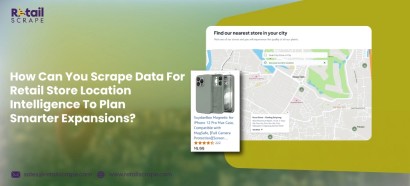


Companies now scrape retail store location data to improve site selection, competitor analysis, and make smarter, data-driven expansion decisions.
Introduction
In today’s fast-changing retail environment, where margins are tight and competition fierce, smart expansion decisions rely on accurate, real-time data. From neighborhood demographics to competitor presence and property availability, reliable information is crucial. That’s where the ability to Scrape Data for Retail Store Location Intelligence comes in—helping retailers make more informed decisions on where to grow.
Traditional market reports and guesswork are becoming outdated. Leading retailers are now adopting Retail Store Intelligence Scraping to gather hyperlocal insights from digital sources in real time. This shift empowers businesses to identify high-opportunity locations, reduce expansion risk, and improve profitability.
This blog explores how scraping location data can refine your expansion strategy, from the types of datasets involved to techniques and business applications.
The Role of Location Intelligence in Retail Expansion
The success of a new retail store often hinges on location. A poor choice can lead to financial losses, while the right one can drive early profitability. Location intelligence enables retailers to answer essential questions, such as:
Who lives in the area?
How saturated is the local market with competitors?
How accessible is the location for suppliers and logistics?
What are historical sales or footfall patterns?
What’s the commercial viability or zoning regulation of the region?
By using Retail Store Location Data Scraping, businesses gain real-time insights from publicly available online sources—supporting confident and strategic expansion.
What Data Can Be Scraped for Location Intelligence?
Store Locator Pages
Retailers often publish structured location data on their websites. Through Store Locator Data Extraction, brands can collect:
Store addresses, zip codes, and contact details
Operating hours and services offered
Geo-coordinates for mapping
Store format variations (flagship, express, etc.)
This helps analyze market coverage and identify underserved regions.
Real Estate Listings
Scraping commercial property listings helps evaluate expansion costs and feasibility. Brands can extract:
Lease terms, property sizes, and rent data
Availability timelines
Foot traffic metrics
Zoning regulations and area development
This ensures new locations align with both budget and strategy.
Social & Review Platforms
User-generated content offers a customer-centric view of retail locations. Retailers can analyze:
Reviews and ratings
Check-in data indicating footfall trends
Common complaints or compliments
Local sentiment to refine store format or service
E-commerce Fulfillment and Delivery Zones
Today’s retail includes physical stores, dark stores, and micro-fulfillment hubs. E-Commerce Store Location Scraping enables brands to assess:
Delivery coverage zones
Local pickup points
Demand hotspots for last-mile services
Techniques for Retail Location Data Scraping
Effective Retail Store Intelligence Scraping combines multiple techniques, including:
HTML Parsing for extracting structured location elements
API Integration to pull clean, updated datasets
Geo-Spatial Scraping for mapping coordinates
AI-Based Pattern Recognition to adapt to varying website structures
The result is not just raw data but usable insights for location planning and market prioritization.
Building a Data-Driven Retail Expansion Strategy
With location intelligence, retailers can:
Score Markets by analyzing demographics, competition, and real estate viability
Optimize Store Formats based on space constraints and consumer behavior
Forecast Sales using footfall and competitor data
Disrupt Competitors by targeting underserved zones
Streamline Operations by aligning new stores with existing logistics networks
Why Real-Time Store Location Scraping Matters
Retail success often depends on timing. Real-Time Store Location Scraping for Retail Growth ensures businesses can:
Track competitor openings instantly
Monitor service area changes
Stay informed on real estate shifts
Respond quickly to customer feedback trends
These real-time insights support faster, more accurate decision-making.
Success Story
A mid-sized electronics retailer used Retail Store Location Data Scraping to analyze over 3,000 competitor outlets and real estate trends. Within 9 months:
8 stores launched successfully
Real estate costs dropped by 23%
Sales exceeded forecasts by 18%
How Retail Scrape Can Help
Retail Scrape provides scalable, custom scraping services, including:
Store locator and e-commerce location extraction
Competitor mapping
Real-time data updates
Visual heatmaps for market potential
Ethical, compliant scraping practices
Conclusion
Choosing the right location starts with the right data. By leveraging Retail Store Intelligence Scraping, businesses can reduce risk, optimize investments, and drive smarter growth. Ready to enhance your expansion strategy? Connect with Retail Scrape for tailored solutions today.
